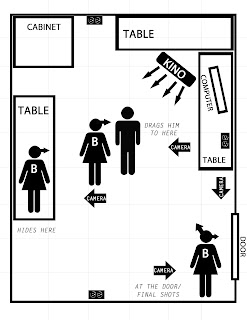In preparation for shooting my scripted scene assignment, I've compiled a production notebook that contains everything I'll need to stay organized on set and to ensure that the shoot goes smoothly. Inside are the script, shooting script, room layout and lighting plan, shot list, foley list, storyboard, and more.
The shooting script in my book has been annotated with shot numbers so that we can keep up with what's been covered already and what we need to shoot next.
For me, one of the greatest benefits of extensive pre-production planning is storyboarding. I always try to visit the location before the shoot to map out the lay of the room and spot available electrical outlets. I like to pace off the room to get a feel for its general dimensions, then map the whole thing out roughly in Photoshop or in 3D in Google Sketchup or FrameForge.
Once this is done, it's much easier to get a feel for the blocking and to quickly make decisions about lighting placement and such. Once you have a rendering of the room in front of you, problems with the space become much more apparent, saving you the time of running into those problems unexpectedly while you have crew standing around waiting to shoot.
After the room has been mapped, I usually get to work on a storyboard and sketch out a basic version of the types of shots I'd like to see. It is usually during this process that I feel I get the most inspiration as far as camera work is involved because I can see the composition of each shot as a tangible thing, juxtaposed together, in a way that lets me start editing the film in my head and working out the flow of the various sequences.
I also find that storyboarding helps me to start identifying a concrete visual style for the project, as the tone and emotion of the scenes tend to influence the way in which I draw the cells. I can't stress enough the importance of storyboarding in my particular creative process. For me, it's the stage where the idea becomes a visual reality for the first time.




No comments:
Post a Comment